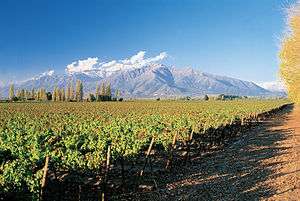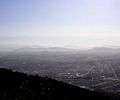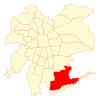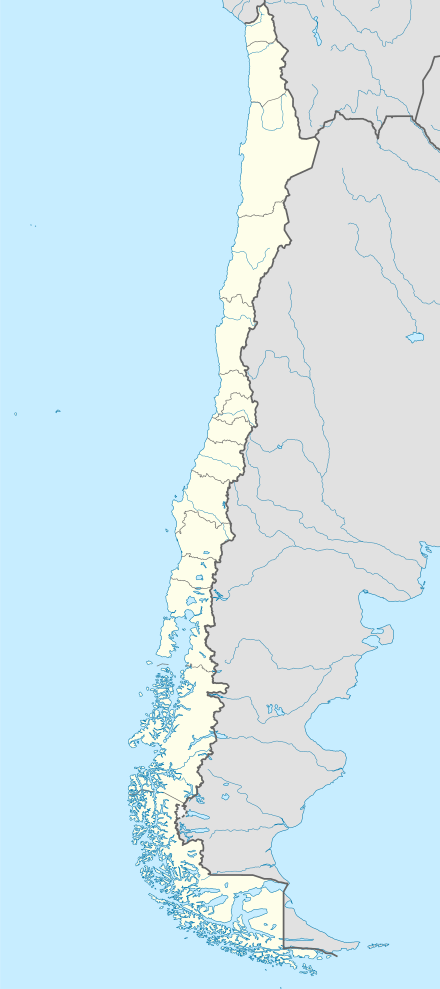Puente Alto
| Puente Alto | |||||
|---|---|---|---|---|---|
| City and Commune | |||||
 Concha y Toro vineyard in Puente Alto | |||||
| |||||
| Coordinates (city): 33°37′S 70°34′W / 33.617°S 70.567°WCoordinates: 33°37′S 70°34′W / 33.617°S 70.567°W | |||||
| Country | Chile | ||||
| Region | Santiago Metro. | ||||
| Province | Cordillera | ||||
| Founded | 1898 | ||||
| Government[1] | |||||
| • Type | Municipality | ||||
| • Alcalde | Germán Codina Powers (RN) | ||||
| Area[2] | |||||
| • Total | 88.2 km2 (34.1 sq mi) | ||||
| Elevation | 673 m (2,208 ft) | ||||
| Population (2012 Census)[2] | |||||
| • Total | 573,935 | ||||
| • Density | 6,500/km2 (17,000/sq mi) | ||||
| • Urban | 492,603 | ||||
| • Rural | 312 | ||||
| Sex[2] | |||||
| • Men | 240,862 | ||||
| • Women | 252,053 | ||||
| Time zone | UTC-4 (CLT [3]) | ||||
| • Summer (DST) | UTC-3 (CLST [4]) | ||||
| Area code(s) | country 56 + city 2 | ||||
| Website | Municipality of Puente Alto | ||||
Puente Alto (Spanish: "High Bridge") is a city and commune of Chile. It is the capital of the Cordillera Province in the Santiago Metropolitan Region. Located at the south of the Great Santiago conurbation (of which it is part), it houses 573,935 inhabitants (city proper, 2012 census), making it the second largest city in Chile.
History
After 1883, the province of Santiago was divided into three departments: Santiago, La Victoria and Melipilla. In 1891 the "Autonomic Commune Law" was enacted, after which the president signed as the "Decree of the Creation of Municipalities."
From this decree the department of La Victoria was divided into the municipalities of Peñaflor, Talagante, Calera de Tango, San José de Maipo y Lo Cañas.
According to regional law, the authorities of this new sector would be able to increase in proportion to the number of inhabitants in the area, as well as adding three additional mayors the bureaucratic structure. This law was passed with the aim of giving more individual power to the remote areas of the fast-growing city, instead of everything being governed as a whole under La Victoria.
Annexation to Santiago
Decades ago, Puente Alto was considered a village on the outskirts of Santiago (like Maipú and San Bernardo), but the steady growth of Santiago, and to a lesser degree Puente Alto, resulted in the union of two cities (as was eventually Maipú and San Bernardo).
The commune is still not totally unified with Santiago - there are a few unique exceptions that are part of Puente Alto but not Santiago, most notably in the Third Sector of Puente Alto. From Concha y Toro Avenue to Avenida La Serena- 4 Oriente there are places where, for some reason, the annexation into Santiago failed or has yet to be complete
Demographics
According to the 2002 census of the National Statistics Institute, Puente Alto spans an area of 88.2 km2 (34 sq mi) and has 492,915 inhabitants (240,862 men and 252,053 women). Of these, 492,603 (99.9%) lived in urban areas and 312 (0.1%)
Stats
Administration
As a commune, Puente Alto is a third-level administrative division of Chile administered by a municipal council, headed by an alcalde who is directly elected every four years. The 2012-2016 alcalde is Germán Codina Powers (RN).[1] The communal council has the following members:
- Emardo Hantelmann Godoy (RN)
- Bernardita Paul Ossandón (RN)
- María Teresa Alvear Valenzuela (PDC)
- Carmen Andrade Lara (PS)
- Fernando Madrid Catalán (PPD)
- César Bunster Ariztia (PC)
- Luis Escanilla Benavides (PS)
- Gustavo Alessandri Bascuñan (IND)
- Juan Marticorena Franco (RN)
- Alfredo Villavicencio Clavero (RN)
Within the electoral divisions of Chile, Puente Alto is represented in the Chamber of Deputies by Mr. Osvaldo Andrade (PS) and Mr. Leopoldo Pérez (RN) as part of the 29th electoral district, ( together with Pirque, San José de Maipo and La Pintana). The commune is represented in the Senate by Manuel José Ossandón Irarrázaval (RN) and Carlos Montes Cisternas (PS) as part of the 8th senatorial constituency (Santiago-East).
Transportation
Puente Alto is connected to the rest of Santiago vía two forms of organized public transportation.
First, the Metro Bus, which can be taken from anywhere in Puente Alto to arrive eventually to downtown Santiago.
Puente Alto is also home to the most southerly station of the Santiago Metro, Estación Plaza de Puente Alto. Travel time to downtown Santiago by metro train is approximately 45 minutes.
Areas of Interest
Estadio Municipal
Puente Alto`s city stadium is located in #450 Nemesio Vicuña Street, it has a soccer playing field and an athletics track. It has a capacity of 1900 people, making it one of the biggest sport centres of the commune including the sports complex Amador Donoso in this list.
In May 30th, 2011 the city stadium was re-inaugurated by the Mayor Manuel J. Ossandón, a lot of neighours were invited to the opening ceremony.
The stadium has 4 bathroom, smart illumination, and 10 exercise machines available to the people of the town[7]. There are no requirements to use these facilities.
Mampato Amusement Park
Mampato is an amusement park which has different games for children and teenagers. It was opened in 1975 by Mr. Felipe Rodríguez Lobbé in Lo Barnechea.
Its main attractions were the trains, the trampolines and tricycles. In addition, there was a show called "Far West", where there were Cowboys and Indians.
It was inaugurated in 1998 in Las Vizcachas, Puente Alto. Currently the rides are a wheel, train, roller coaster and slide. Apart from these, Mampato has got many other rides.
The general ticket costs 7.000 Chilean pesos.[8]
Pueblito Las Vizcachas
"Pueblito las Vizcachas" is a big and very beautiful park in Puente Alto for many families and neighbours. It opened on December 30, 2015.
Many people visit this place every weekend since there is no entry fee for visitors.
Can practice kayaking, look at different farm animals, make picnics, do sport and other activities in the great green areas.
It was created by mayor Germán Codina. He also planeed restaurants in the park for the year 2019.
Gallery
 North of Puente Alto
North of Puente Alto Mall plaza Tobalaba
Mall plaza Tobalaba Trail in the Puentealtina Pre-cordillerana Reserve, in eastern Puente Alto
Trail in the Puentealtina Pre-cordillerana Reserve, in eastern Puente Alto An old-style neighbourhood typical to Puente Alto, near the civic centre.
An old-style neighbourhood typical to Puente Alto, near the civic centre. Monte Andino, an upper middle class neighbourhood located in the northeast part of the commune. It follows the same style as other neighbourhoods in that area.
Monte Andino, an upper middle class neighbourhood located in the northeast part of the commune. It follows the same style as other neighbourhoods in that area. Sótero del Río Hospital
Sótero del Río Hospital Town hall
Town hall
See also
- Juventud Puente Alto
References
- 1 2 "Municipality of Puente Alto" (in Spanish). Retrieved 3 December 2010.
- 1 2 3 "National Statistics Institute" (in Spanish). Retrieved 3 December 2010.
- ↑ "Chile Time". WorldTimeZones.org. Archived from the original on 2010-07-13. Retrieved 2010-07-29.
- ↑ "Chile Summer Time". WorldTimeZones.org. Archived from the original on 2007-09-11. Retrieved 2010-07-29.
- ↑ Sistema de Información Regional, Ministry of Planning of Chile. Archived April 23, 2008, at the Wayback Machine.
- ↑ "Poverty in the Santiago Metropolitan Region" (PDF). Ministry of Planning of Chile (in Spanish). Archived from the original (PDF) on August 24, 2007.
- ↑ "Estadio Municipal". Corporación Municipal. Retrieved 2017-11-15.
- ↑ "Mampato, Parques de Diversiones". Mampato, Parques de Diversiones. Retrieved 2017-11-15.



